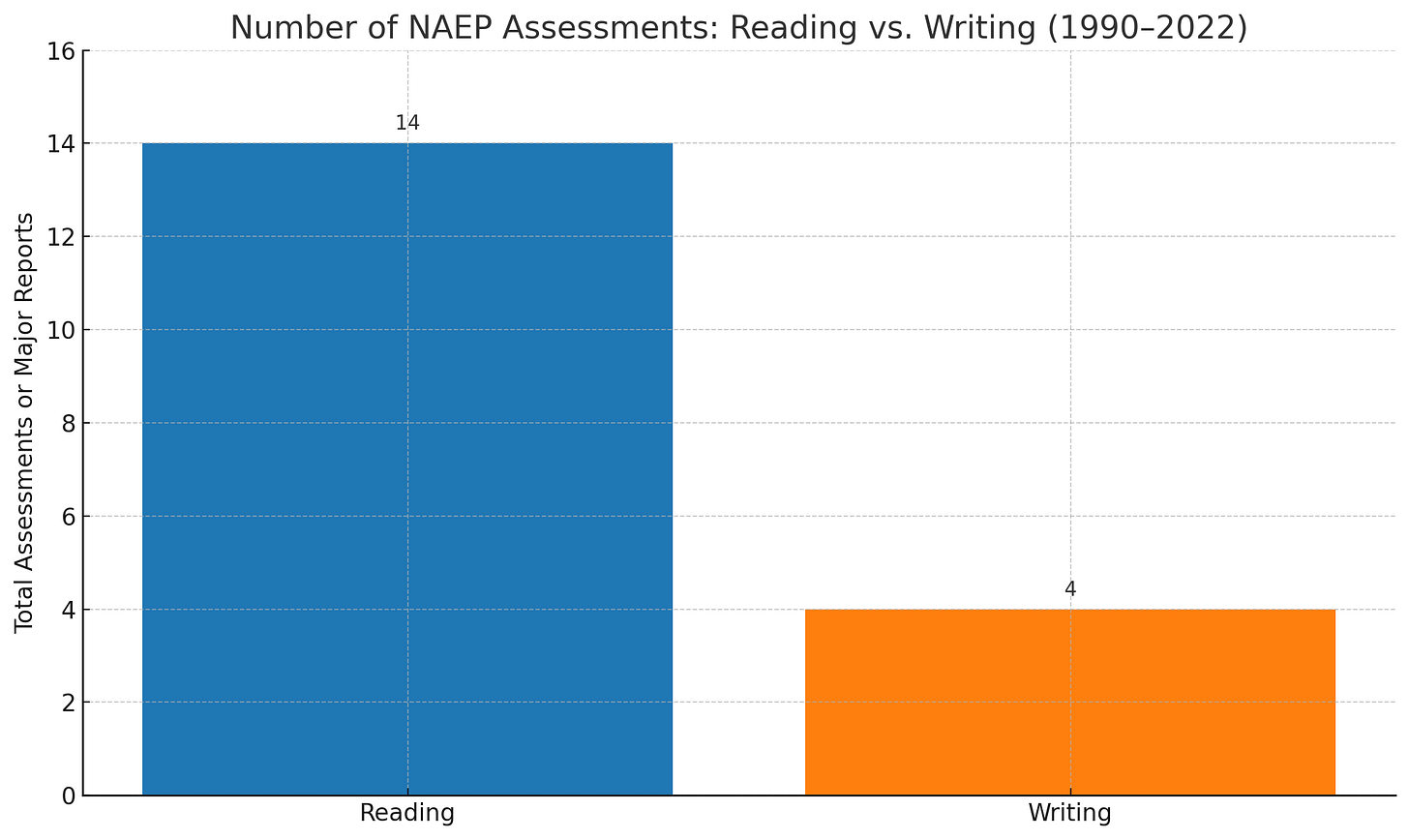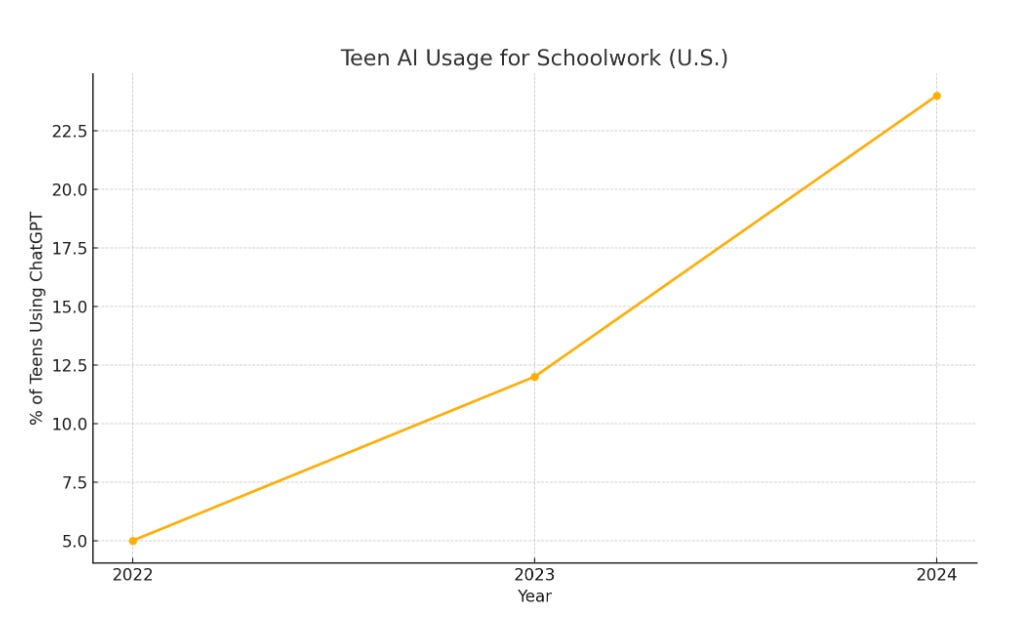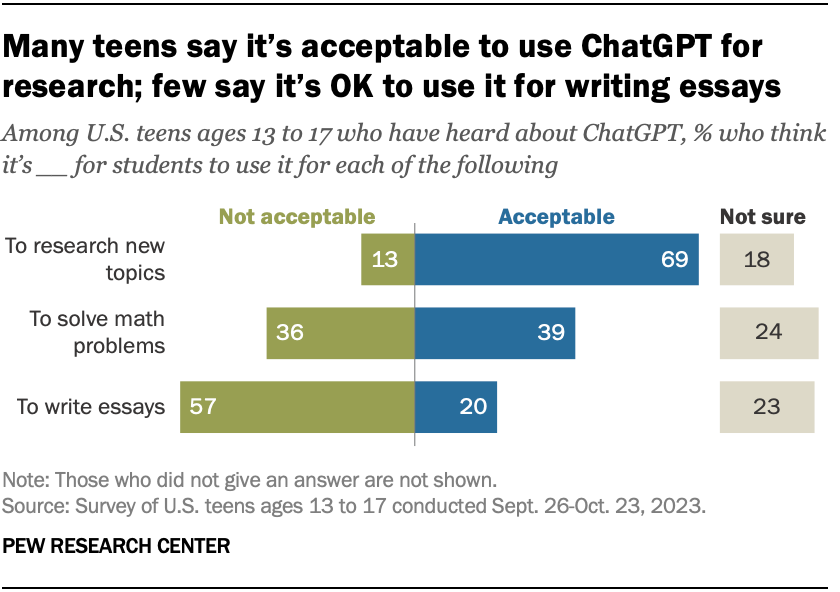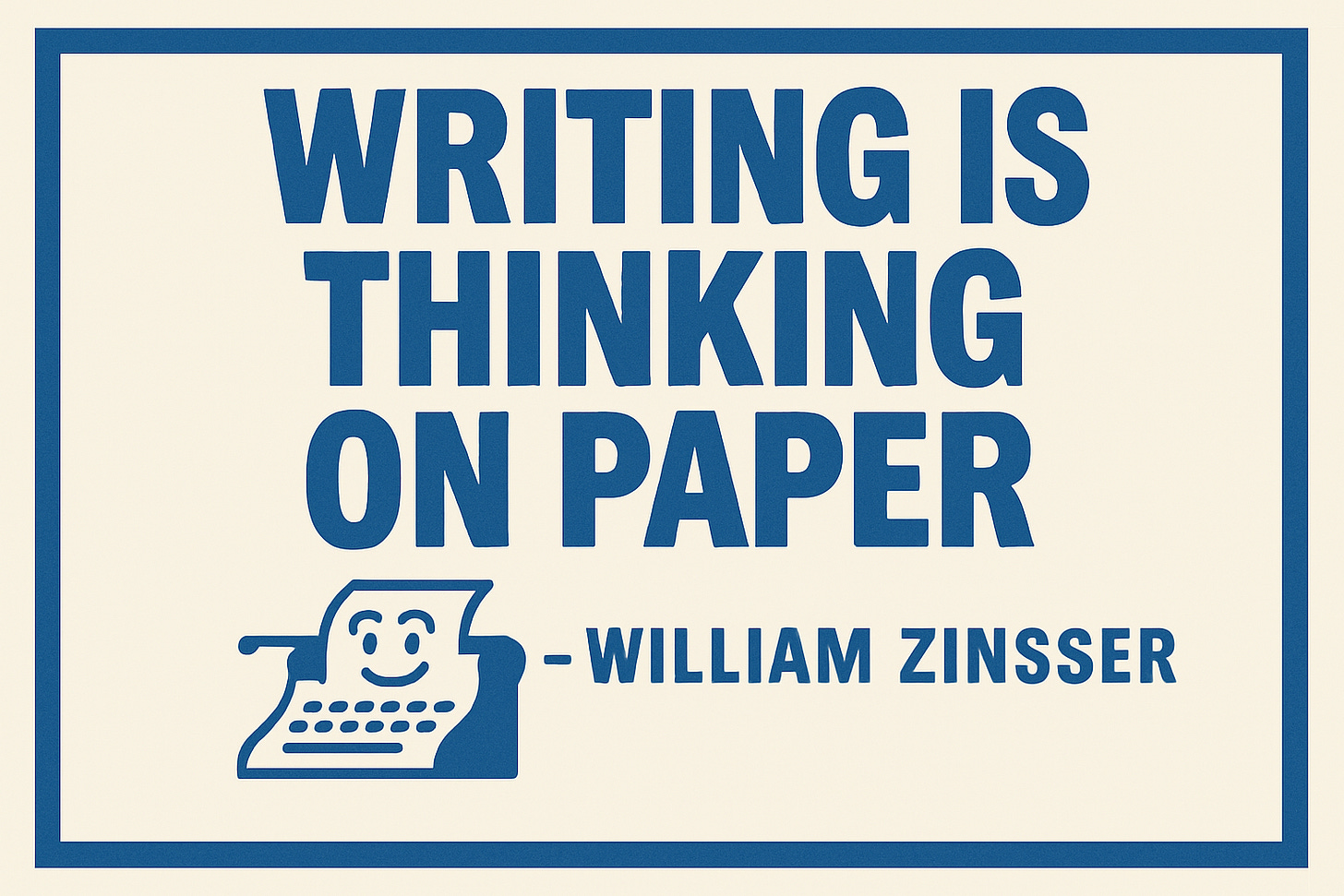Building AI Models for Education: Writers Edition
If we build it right, AI won’t diminish writing instruction—it will democratize it
Correction: An earlier version of this post incorrectly attributed the quote “Writing is thinking on paper” to Joan Sedita. The quote should be correctly attributed to William Zinsser. We regret the error and have updated the attribution.
The rise of generative AI is transforming writing instruction—quickly, deeply, and irreversibly. Since ChatGPT’s launch in late 2022, it has become the fastest-adopted consumer technology in history, and students were among its earliest adopters.
By the end of 2024, nearly one in four U.S. teens had used it for schoolwork—double the share from the year before.
This raises an urgent question: If AI can generate paragraphs, essays, or even feedback in seconds, what role does writing instruction still play?
The answer—backed by decades of research and educator experience—is an essential one. Writing is not just about producing words; it's about thinking, learning, organizing, and expressing. In this post, we’ll explore how to build and use AI tools in ways that honor this truth, grounding innovation in the Science of Writing and the best of what educators know works.
Why Writing Still Matters in an AI World
The temptation for students to let AI “do the writing” is real. But research is unequivocal: writing instruction remains one of the most powerful drivers of literacy, learning, and critical thinking across all disciplines and subject areas.
Studies show that students who write about what they read—through summaries, responses, or explanations—develop stronger reading comprehension than students who only read or discuss texts. As William Zinsser puts it, writing is “thinking on paper.” It's how students clarify ideas, synthesize information, and build long-term understanding.
Writing instruction also strengthens foundational reading skills. Teaching students to build and expand sentences improves their grasp of grammar and syntax—skills that carry over into decoding and fluency. And learning text structures (like sequence, cause and effect, or argument) helps students recognize and retain those patterns while reading.
The relationship between reading and writing is symbiotic—and AI doesn’t replace that. Instead, it should reinforce and expand opportunities for students to engage deeply with language.
And yet, when it comes to national assessments and educational priorities, writing has often taken a back seat. A quick look at NAEP’s assessment history makes it clear: reading is assessed regularly and extensively—writing, far less so.

That gap matters. If we’re not measuring writing, we’re not investing in improving it—and we risk sending the message that writing is secondary, when it’s actually foundational to learning across all subjects.
The Writing Rope: A Blueprint for AI Integration
Sedita’s “Writing Rope,” adapted from Scarborough’s Reading Rope, provides a helpful framework for how writing develops. It identifies five interwoven strands:
Critical Thinking (idea development and planning)
Syntax (grammar and sentence fluency)
Text Structure (organization and flow)
Writing Craft (voice, word choice, style)
Transcription (spelling, typing, handwriting)
Effective writing instruction teaches and reinforces each of these strands. AI tools should do the same—not shortcut the process but support it in thoughtful, strategic ways.
Let’s explore how.
How AI Can Support Each Strand
1. Critical Thinking and the Writing Process
AI can serve as a brainstorming partner, suggesting prompts or posing reflective questions. Pressto’s AI, for example, helps elementary students overcome the blank page by offering personalized sentence starters and idea blocks that spark engagement.
Planning and outlining tools can help structure ideas—like graphic organizers or scaffolded templates. During revision, AI might ask: “Can you explain this idea further?”—nudging the student toward deeper analysis.
2. Syntax: Sentence Fluency and Grammar
AI grammar tools provide real-time feedback: highlighting run-ons, verb agreement issues, or punctuation errors. But caution is critical. If AI always corrects students automatically, they may never learn the grammar themselves.
Pressto’s approach is instructive: early drafts have grammar checkers disabled so that students can focus on ideas without fear of mistakes. Research has shown that corrective feedback too early can be a major roadblock to student progress. Grammar instruction then happens with the teacher in the revision phase, allowing creativity and clarity to emerge in tandem.
3. Text Structure: Organizing Ideas
Good writing starts with a plan. Tools like Pressto allow teachers to assign a writing plan. Students can also select a writing plan before they begin.
Students can use a ‘Compare and Contrast’ plan to write about two animals they’ve studied in science class, for example.
Used wisely, AI can reinforce patterns of strong organization—but only after students first attempt it themselves. Structure must ultimately be learned through practice, not prefilled.
4. Writing Craft and Style
This is where AI must tread most carefully. Voice and style are deeply personal—core to a writer’s identity. While AI can suggest stronger verbs or flag tonal shifts (e.g., “This sounds very formal—was that your goal?”), it should never dictate phrasing or overwrite intention.
The risk is that student writing becomes formulaic, bland, or overly polished in a way that erases individuality. Students need to understand: AI can offer suggestions, but you—the writer—make the decisions. Craft is where human creativity, personality, and agency must stay firmly in control.
5. Transcription: Getting Words on the Page
In Sedita’s original Writing Rope, “transcription” refers to the foundational mechanics of writing—handwriting, spelling, typing, and punctuation. These are often overlooked, but they’re essential: if students struggle with the physical act of getting words on the page, their higher-level writing skills (like organization and voice) can’t fully develop. In early grades, transcription means learning to form letters and spell phonetically. In later grades, it includes keyboard fluency, proper punctuation, and conventions that allow ideas to flow smoothly.
Today, however, transcription also intersects with accessibility. Many students face real mechanical barriers—dyslexia, dysgraphia, fine motor challenges—that can make transcription a source of frustration. This is where AI-powered tools can provide vital support. For example, speech-to-text allows a student to “write” with their voice, bypassing the motor demands of typing or handwriting. Smart spell-checkers help students produce readable drafts, even if spelling is still developing. These tools don’t replace the need for explicit instruction in mechanics—but they can level the playing field, freeing up students’ cognitive energy to focus on composition, structure, and meaning.
In other words, AI should scaffold the act of writing—never substitute the development of it.
The Science of Reading also reminds us that spelling reinforces decoding and phonics. So while AI tools can assist transcription, they shouldn’t fully automate it. A thoughtful balance is key. Some students might draft via dictation, then revise manually. Others might type first, then review spelling errors with targeted guidance. In each case, AI should reduce barriers—not bypass skill-building.
Used well, transcription support makes writing more equitable. It ensures that students’ ideas aren’t held hostage by their mechanics, while still building those mechanics over time. In this way, the transcription strand becomes not only a foundation—but also a gateway to expression.
AI as Coach, Not Crutch
The best way to think about AI in writing education? A coach—not a ghostwriter.
Good coaches ask questions, offer advice, and push writers to grow. They don’t hand over finished work. That same principle should guide AI development.
Here are a few roles AI can play:
Idea Generation: Tools like Pressto generate prompts tailored to student interests.
Real-Time Feedback: AI grammar support highlights issues without auto-correcting, so students learn from their mistakes.
Scaffolded Revision: AI can suggest additions, spot inconsistencies, or prompt clarity—but the student makes the edits.
Personalized Practice: Systems like Packback’s Deep Dives give rubric-based feedback aligned to each student’s needs, boosting revision and engagement.
Used thoughtfully, AI amplifies what teachers already do well—and extends their reach.
From Calculators to Composition: Why “Show Your Work” Still Matters
This shift mirrors a moment from math education history.
When calculators first entered classrooms, many teachers worried they would undermine students’ ability to perform basic calculations. And for a time, that fear seemed valid—some students did rely too heavily on the calculator.
But the field adapted.
Today, calculators are an accepted part of math instruction—not because we abandoned skills practice, but because we raised the bar. Students still learn arithmetic by hand—but they also learn to model, estimate, solve complex problems, and, most importantly, show their work.
In fact, showing your reasoning became even more essential once the answer itself was no longer enough.
The same evolution is happening now in writing.
Tools like Pressto bring “show your work” to writing instruction. They don’t just generate text—they guide students through the thinking process behind it: planning, structuring, revising, and reflecting.
With the right AI tools, we’re not replacing writing skills—we’re elevating them.
Building AI That’s Aligned With the Science of Writing
To truly support education, AI must be built for classrooms—not retrofitted after the fact. Here’s what that means in practice:
1. Ground Tools in Research
AI writing models should reflect evidence-based practices from the Science of Reading and Writing. That means prompting planning, encouraging revision, and reinforcing text structure—not just generating content.
2. Keep Humans in the Loop
Teachers should remain central. Dashboards can show what AI assisted with; controls can let educators customize difficulty or turn off features. The goal: collaboration, not replacement.
3. Guard Against Bias and Inaccuracy
AI must be tuned for educational reliability—fact-checking sources, avoiding “hallucinations,” and respecting cultural and dialectal diversity. Fairness, transparency, and data privacy are non-negotiable.
4. Iterate with Real Feedback
Just like writing, AI should evolve through drafts. Developers should learn from classroom use: What inspires students? What confuses them? What needs adjusting?
When teachers, researchers, and developers collaborate, AI tools get better—and more human.
A New Chapter in Writing Instruction
Writing is changing. But its importance is not fading—it’s expanding.
In the coming years, students will not just need to write essays. They’ll need to write with AI. That means knowing when to ask for help, how to evaluate suggestions, and how to maintain their own voice in a world of machine language.
The goal isn’t to shield students from AI. It’s to prepare them to think with it. To stay in charge. To become confident, capable writers in any context.
When AI is built with care, aligned to research, and guided by educators, it can help every student get the support they need—and help every teacher focus more on what matters most: nurturing the writers and thinkers of tomorrow.
Author bio: Daniel Stedman is an educator, edtech founder, and co-creator of Pressto. He writes regularly about the intersection of literacy, AI, and learning design for The Science of Writing. He was previously the founder of Brooklyn Magazine.









While reading your article, I had to stop when I saw the words you attributed to Sedita. I am not sure when or where Sedita first connected writing and thinking. I have seen the quote attributed to Zinsser’s 1976 book.
“Writing is thinking on paper” (Zinsser, 1976, p. vii).
Zinsser, W. (1976). On writing well: The classic guide to writing nonfiction. HarperCollins.
I will resume my reading now.